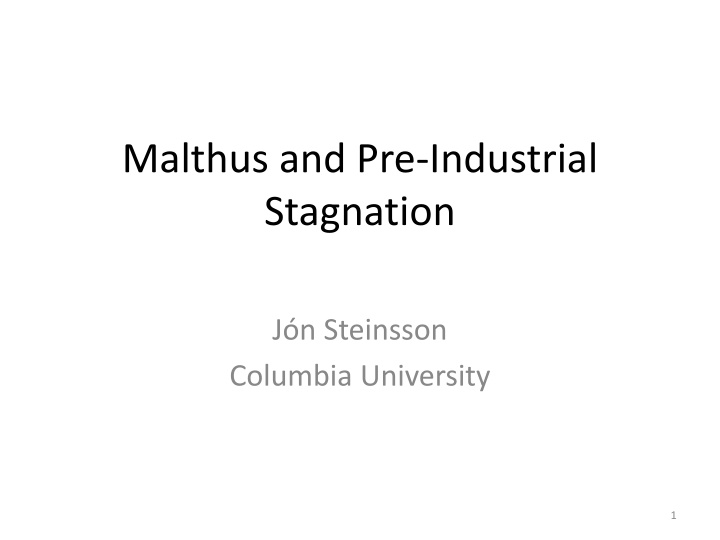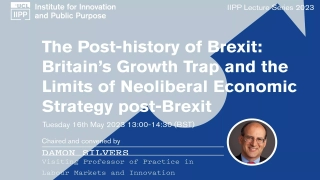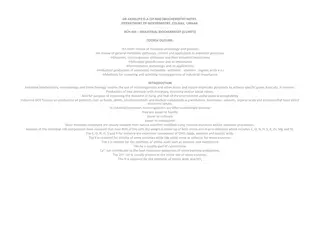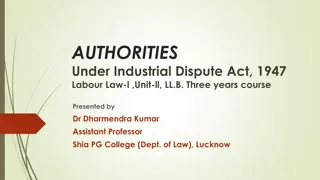Malthus, Pre-Industrial Stagnation in Steinsson's Work
This content explores the relationship between Malthusian theory and pre-industrial stagnation as discussed in Jn Steinsson's work at Columbia University. The discussion sheds light on the implications of Malthusian economics in understanding historical periods of economic slow growth and the factors contributing to such stagnation. Steinsson's research provides valuable insights into the underlying mechanisms that may have shaped pre-industrial economies.
Download Presentation

Please find below an Image/Link to download the presentation.
The content on the website is provided AS IS for your information and personal use only. It may not be sold, licensed, or shared on other websites without obtaining consent from the author.If you encounter any issues during the download, it is possible that the publisher has removed the file from their server.
You are allowed to download the files provided on this website for personal or commercial use, subject to the condition that they are used lawfully. All files are the property of their respective owners.
The content on the website is provided AS IS for your information and personal use only. It may not be sold, licensed, or shared on other websites without obtaining consent from the author.
E N D
Presentation Transcript
Malthus and Pre-Industrial Stagnation J n Steinsson Columbia University 1
Long Run Growth Remarkable transformation of standards of living over last 200 years In contrast, prior to 1800, standards of living were stagnant Best hard evidence: Gregory Clark (2005) Data on real wages of building workers in England back to 1209 2
Real Wages of Laborers in England from 1250 to 2000 960 480 240 120 60 30 1250 1350 1450 1550 1650 1750 1850 1950 Source: Clark (2005) 3
Evidence on Real Wages Real wages trendless before 1800 Some fluctuations, but no trend Sustained growth begins around 1800 in Britain (and then spreads from there) 18th and 19th century Britain is a major turning point in history which we now refer to as the Industrial Revolution 4
Key Questions About Origins of Growth Why was there no growth before the Industrial Revolution? Why did the Industrial Revolution happen? Why did it happen in 18th and 19th century? Why did it happen in Britain? Why did the Industrial Revolution result in modern sustained growth? (Why didn t it peter out?) 5
Why No Growth Before the Industrial Revolution? Despotism: Those that grew rich got attacked by poorer neighbors (risk of expropriation lead to huge defense costs which retarded incentives to grow) Vested interests: Advancement of knowledge was slow because of powerful forces working against innovators and defending status quo Population dynamics: Higher wages lead to population growth, which pushed down wages 6
Malthus Idea In 1798, Thomas Malthus published an essay titled An Essay on the Principle of Population Argued that sustained growth in real wages was impossible in the long run: If real wages increased, this would lead to an increase in population that would only stop when wages had been bid down to subsistence This is where economics got the nickname: The Dismal Science 7
Malthus Unfortunate Timing 8 Source: Clark (2005)
Malthus Model: Production 1. Production Function: 1 ? ??= ?????? ?? denotes output at time t ?? denotes productivity at time t ? denotes land (constant over time) ?? denotes labor at time t Production function is constant returns to scale in land and labor. But land is fixed. There are diminishing returns to labor alone. 9
Malthus Model: Labor Demand 2. Labor Demand: We assume that there is a competitive labor market. As in chapter 2, firms will hire labor to the point at which wage is equal to marginal product of labor ? ? ?? ??= 1 ? ?? 10
Malthus Model: Labor Supply 3. Labor Supply: Labor supply equals hours per person times population: ??= ???? For simplicity: ??= ? (hours constant) 11
Malthus Model: Population Growth 4. Population Growth: Population growth governed by real wage: ??+1=?? ???? ?? subsistence wage Population will growth when standard of living is above subsistence 12
Malthus Model: Population Growth People have a natural tendency to continually produce children Absent checks on this, population will grow Positive checks increase death rate (war, disease, severe labor, poverty) Preventive checks reduce birth rate (birth control, delayed marriage, infrequent coitus) Simplest formulation: Abject poverty only check that is sufficiently strong to stop population growth 13
Malthus Model: Population Growth Rewrite equation as: ??+1 ?? =?? ?? Population grows whenever wages are above subsistence (??> ??) Population shrinks whenever wages are below subsistence (??< ??) 14
Malthus Model: Plagues One more element important to make sense of data in middle ages: Plagues Plagues modelled as an exogenous shock to population growth ?? Population growth equation becomes: ??+1 ?? Years with no plague ??= 1 Years with plague ??< 1 ?? ???? = 15
The Malthus Model: Key Equations ? ? ??= 1 ? ?? ??? ??+1 ?? ?? ???? = How many endogenous variables? Two for each time period: ?? and ?? Dynamic model: Population growth equation links period ?and period ? + 1 Solution at period ? + 1 depends on outcome in period ? 16
Population Dynamics Let s plug the labor demand equation into the population growth equation : ??+1 ?? ??+1 ?? ?? ?? ???? = ? 1 ? ?? ? = ?? ??? 17
Population Dynamics ??+1= ???????1 ? Non-linear difference equation (difficult to solve analytically) We solve it graphically 18
Population Dynamics ??+1= ???????1 ? Suppose for simplicity that ??= 1 and ??= 1 ??+1= ???1 ? If ???1 ?>?? then ??+1> ?? If ???1 ?< ?? then ??+1< ?? If ???1 ?= ?? then ??+1= ?? 20
Steady State Population ??+1= ???????1 ? A steady state for ??is a value for ?? at which ??+1= ??, i.e., the population is steady Population will reach such a point after long period of no shocks (e.g., ??= 1 and ??= 1) We denote steady state for ?? by ? We can solve for the steady state analytically 22
Solving for Steady State 1. Suppose there is a steady state ?. Then ??+1= ??= ?. So, replace ??+1 and ?? with ? in population dynamics equation. Also, set shocks to normal values (i.e., ??= 1): ? = ??? ?1 ? 2. Solve for ?: 1 ? ? = ??? 23
Wages and Population ? ? ??= 1 ? ?? ??? Using definition of ?: 1 ??= ????? ? ?? In ??,?? space, what does this equation look like (for a given level of ??)? Downward sloping and convex 24
Labor Demand 25
The Malthus Model Graphical analysis consists of four key plots: 1. Population dynamics plot (??+1 against ??) ??+1= ???????1 ? 2. Labor demand plot (?? against ??) ? ? ??= 1 ? ?? ??? 3. Time-series plot of population (?? against ?) 4. Time-series plot of wages (?? against ?) 26
Responses to Shocks What happens to population and wages in the short run and long run after these shocks: Black Death (??< 1)? Increase in technology (??> ?? 1)? 27
Black Death 28
Black Death 29
Responses to Shocks What happens to population and wages in the short run and long run after these shocks: Black Death (??< 1)? Population falls in the short run but returns to same steady state. Wages rise in the short run but then fall to same steady state Increase in technology (??> ?? 1)? Population begins to grow and grows to new steady state Wages rise in the short run but then fall to same steady state 32
Growth Before 1500 Different meanings of growth : Growth in individual income and wellbeing Growth in GDP per person Growth in productivity Malthus model highlights difference: Increase in productivity does not lead to higher real wages in the long run Increase in productivity leads to larger population 33
Growth in Productivity Before 1500 Malthus model suggests different way to assess growth in productivity Long-run changes in population are an indirect measure of long-run changes in productivity Consider: ??+1= ???????1 ? Ignore plagues and take ratio: ??+1 ?? ?? 1 1 ? ?? ?? ?? 1 = 34
Growth in Productivity Before 1500 Take logarithms: ??+1 ?? Recall that log 1 + ? ?: ???+1= ???+ 1 ? ??? Steady state: ?? ?? ?? 1 log = log + 1 ? log ?? 1 ??= ??? Growth in productivity proportional to growth in the population (0 < ? < 1) 35
Wages in England 1250-1860 Can we use the Malthus model to make sense of the evolution of real wages in England from 1250 onward? 37
Real Wages of Laborers in England from 1250 to 2000 960 480 240 120 60 30 1250 1350 1450 1550 1650 1750 1850 1950 Source: Clark (2005) 38
Wages in England 1250-1850 Two striking facts: No growth (same in 1750 as in 1250) Big rise (1300-1450) and then fall (1450 to 1640) Malthus model suggests that evolution of the population may help us understand changes in real wages Let s look at a scatter plot of real wages and the population in England over time 39
Real Wages of Laborers in England 1250-1450 Real Wage 100 1450 90 80 1400 70 60 1250 50 1350 1300 40 30 20 0 1 2 3 4 5 6 7 8 Population (millions) 40 Source: Clark (2010)
Real Wages of Laborers in England 1250-1640 41 Source: Clark (2010)
Real Wages of Laborers in England 1250-1640 1250-1310: Population rises and real wages fall 1310-1450: Population falls and real wages rise Black Death in 1340s. Waves of plagues afterwards 1450-1640: Population rises and real wages fall Economy recovers from plagues 42
Success of Malthus Model Big rise and fall of real wages may have seemed puzzling before Malthus model provides an explanation: Real wages rose as plagues halved the population Real wages fell as population recovered 43
Why Did Recovery Take So Long? There were many plagues after 1350 Black Death may have caused a decrease in birth rates European Marriage Pattern: Women married at 25 as opposed to 20 Significant fraction never married Voigtlander and Voth (2013): Black Death lead to shift to pastoral farming Women have comparative advantage at pastoral farming 44
Technical Change in England 1250-1640 1250-1640: Real wages and population moved up and down a stable labor demand curve 1 ??= ????? ? ?? What does this imply about changes in productivity in England from 1250 to 1640? There was essentially no change in productivity (??= ?). No technical change. (Why?) Increases in ?? shift the labor demand curve out 45
Real Wages of Laborers in England 1300-1640 Real Wage 100 1450 90 80 70 60 1600 50 1640 1300 40 30 20 0 1 2 3 4 5 6 7 8 Population (millions) 46 Source: Clark (2010)
Something Changed Around 1650 Real Wage 100 1450 90 80 70 1780 60 1600 50 1650 1300 40 30 20 0 1 2 3 4 5 6 7 8 Population (millions) 47 Source: Clark (2009)
Something Changed Around 1650 Points move off the curve!! What does this mean about productivity? Productivity started increasing (?? started growing) From 1640-1730: Mostly increase in wages Great Plague of London in 1665-6 From 1730-1800: Mostly increase in population Recovery from plagues? Increase in health? Engel s pause? Around 1800: Huge acceleration 48
Real Wages of Laborers in England 1290-1860 Real Wages 90.0 1860 80.0 1450 70.0 60.0 1730 50.0 1800 1650 40.0 1300 30.0 20.0 0 2 4 6 8 10 12 14 16 18 20 49 Population (millions)
Malthus Unfortunate Timing Malthus sometimes get a bad rap Prediction that wages were doomed to stay at subsistence turned out to be wrong after his writing But his theory was arguably correct for all of history up until his writing!! What changed after 1800? 50























